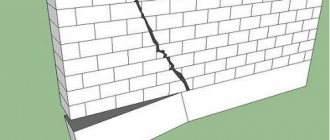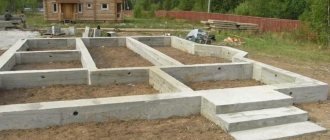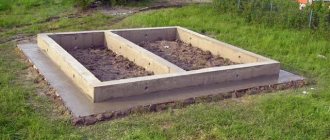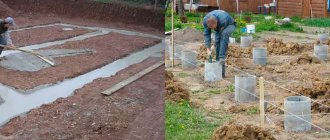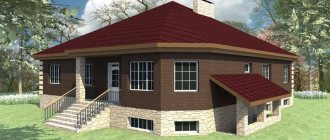Published
05/19/2018 |
Author: kmveg 0
Wood is the most common building material used for the construction of private baths on personal plots. Its main advantage is considered to be affordability and ease of processing. However, wood is different from tree. It is unlikely that anyone today will build a bathhouse made of oak. Of course, the performance characteristics of such a building will be very attractive. But we are talking about affordability first and foremost.
A do-it-yourself bathhouse made of timber (the video is presented at the end of the article) requires a foundation. Many today decide in favor of a moving platform instead of a solid foundation. This approach is more applicable when an old (or new) cabin serves as a bathhouse. A mobile bath also has its advantages. However, if you plan to organize a bathhouse that will be used for many years, professionals recommend giving preference to the traditional construction option.
Choosing a foundation for a bathhouse - which one is best?
Construction of a bathhouse made from logs has recently been in demand in all regions of Russia, because wood is a safe material that does not cause diseases or allergies.
Some types of wood were classically used for the construction of baths (linden), as their wood has healing powers. Installing a log bathhouse with your own hands entails constructing a reliable foundation.
What kind of foundation is better to provide for a bathhouse made of a wooden frame? The answer is in this article.
A log bathhouse is a classic Russian version; such buildings are being built in all regions of our vast country. The popularity of wooden baths partly depends on the fairly economical material, which is not in short supply throughout Russia.
The advantages of wooden baths include environmental safety, quick heating of the washing and steam compartments; efficiency and speed of construction (a log bathhouse is easy to build with your own hands).
There are also plenty of disadvantages to wooden baths: the log house has significant weight, there is a high risk of fire and the occurrence of foci of biological damage (rot, mold and fungus can render a wooden building (log bathhouse) unusable in a very short time).
In order for a bathhouse built from logs with your own hands to serve for many years, it is necessary to carefully construct a support base that can withstand the loads from the weight of the bathhouse, the water boiler, the weight of human bodies, snow loads in winter and other factors affecting the foundation.
The choice of foundation for a log bathhouse depends on many factors:
- The foundation for the bathhouse must be strong and reliable. The first of these is the depth of soil freezing. This indicator determines how deep the foundation needs to be laid, because the support belt must be stable. When the soil thaws in the spring, the bathhouse building lowers unevenly, which greatly affects the strength of the building. When building a foundation belt with your own hands, you need to make several holes in the area to determine the actual depth of soil freezing. It is these indicators that determine the depth of immersion of supporting structures into the ground, and which foundation should be chosen.
- The second is the height of the groundwater level. Groundwater can greatly damage the foundations of a bathhouse, especially if the soils at the building site do not have sufficient bearing capacity. Silty sands and light clay can be washed away by groundwater, which can negatively affect the stability of the log house.
- The third is the geological composition of the soil at the construction site. To determine the composition of the soil on the site, you should dig 3-4 wells more than 1.5 m deep with your own hands to determine what kind of soil lies on the site. The choice of foundation for a log bathhouse largely depends on the geological structure of the site.
If the building site has weak soils, a high level of groundwater and deep freezing of the soil in winter, it is best to build a pile foundation of screw support elements under the log house of the bathhouse.
The foundation on screw piles is excellent for heaving soils
The helical support is a hollow metal rod with welded (or cast) blades and a pointed end.
The piles are easily screwed into the ground with your own hands using a special device threaded into a hole in the upper part of the rod, so this foundation for a bathhouse can be built without the involvement of expensive installation equipment and qualified specialists.
A log house for a bathhouse can be erected on a site with difficult terrain, immersing the screw supports to a considerable depth. The core of screw piles can be easily extended to the required length, so the support can be easily screwed deep enough so that the ends of the piles rest against soil with a high load-bearing capacity.
The use of piles in wet soils is also possible, but in this case, the supports should be treated with anti-corrosion compounds before screwing in, because any scratch on the metal can cause rapid corrosion.
A pile field of screw supports for a bathhouse frame is erected in a fairly short period of time.
Before you start screwing the screw supports into the ground, you should clear the area of debris, uproot trees and shrubs, carefully selecting the roots. It is very important that the trees growing next to the building do not damage the root system of the piles immersed in the soil. Uprooting trees and shrubs is usually easy to do with your own hands.
Proper marking is one of the keys to the reliability of the foundation
Then they begin to mark the places for screwing in the piles, for which the perimeter of the future bathhouse is marked on the site, for which pegs are driven into the corners of the building, along which the cords are pulled. It is absolutely not difficult to do this work with your own hands.
After marking the pile field (screw supports are installed under external and internal load-bearing walls, under stoves, boilers and hearths that have significant weight, it is worth installing separate foundations), they begin to screw in the piles. Two people drive the pile into the ground by rotating the device in the eye clockwise.
To more accurately hit the center of the marking, it is best to first dig pits, the depth of which can be up to 0.5 m. The vertical position of the support is determined by the third worker, carrying out the necessary control using a level.
When all the piles are immersed to certain marks, supports of different heights with eyelets remain above the ground. It is necessary to cut all piles to the same height, monitoring this process using measuring instruments. Hollow supports can be easily cut with your own hands using a specialized power tool.
The internal cavity of the screw piles is filled with concrete mortar, which must harden within a few days. Until the mortar inside the rod gains strength, it is best to suspend other work on the foundation supports.
After the concrete has completely hardened, you can begin installing the headers, which are welded to the top of the supports; they serve to protect the metal rods from moisture penetration. The piles are tied with timber or a channel - the grillage combines the supports into a single foundation belt, which guarantees a more even distribution of the load on the ground.
We suggest you familiarize yourself with: Bath varnish inside - All about the bath
A log bathhouse on a pile foundation can be used for up to 50 years.
Watch the video to see what a log house on a screw base looks like.
The log house of the bathhouse can be installed on strip foundations made of monolithic reinforced concrete, natural stones (cobblestones, rubble). It is allowed to build a bathhouse on prefabricated strip foundations for which reinforced concrete blocks are used. You cannot install prefabricated reinforced concrete with your own hands - you will have to call lifting equipment.
In central Russia, it is enough to equip a shallow foundation for a log house
There are shallow and conventional strip foundations. A shallow-depth tape will require digging trenches with a depth of 0.3 m to 0.7 m. Conventional tape foundations are buried to a distance of up to 1.7 m.
What foundation to choose for a log bath? To answer this question, it is worth determining such site indicators as freezing depth, soil composition and groundwater level.
A finished foundation strip made of monolithic reinforced concrete gains strength in about a month, so you should not plan to start construction in the autumn or early winter, so as not to have to carry out a set of additional work to preserve the foundation for the winter.
Watch the video on how to make a strip base and a concrete subfloor for a bathhouse with your own hands.
A columnar foundation, despite its simplicity, is capable of supporting a significant weight of log baths and light panel buildings that do not create a significant load on the foundation.
Columnar base perfectly resists soil heaving
The log house is installed on poles, which are erected on a plot allocated for construction. It is possible to make a columnar base for a bathhouse from stone or concrete; you can use red clay bricks or make pillars from asbestos-cement pipes and then fill them with concrete mortar.
The installation of pillars should be provided at the intersection of walls and partitions, as well as under external load-bearing walls. The distance between individual pillars ranges from 120 cm to 200 cm.
Columnar supports perfectly resist the forces of frost heaving of the soil, so such a foundation is quite suitable for a log bathhouse, which is being built in the northern regions.
To strengthen the columnar supports, it is necessary to provide a strapping device that will sequentially connect all the supports into a single foundation. For a bathhouse made of wooden materials, a beam made of natural wood can be used as a frame, which is laid on top of the pillars. The strapping beam is also the bottom crown of the bathhouse.
Installing a columnar base does not take much time; the foundation is easy to build with your own hands.
- Weight of the building;
- Features of soil structure.
Important! If you choose the wrong type of foundation and violate the technology of its installation, there is a risk of distortion of the bathhouse structure, even to its destruction.
The most dangerous natural factor for the integrity of the foundation of a building is soil freezing. If there is uneven thawing on one side of the building, the soil may “float”. In this case, even reinforcement will not save a brick foundation. Monolithic foundations made of concrete and metal are much stronger, but they can also crack. For greater stability, anchor platforms are created on such soil.
To determine the nature of the soil, dig a hole up to one and a half meters deep and evaluate the composition of the soil. It is important to investigate the groundwater level. For clay, gravel and sandy soil, a columnar or strip bathhouse foundation structure is more suitable. For soft marsh and garden soil, a pile foundation will be required. The most universal option is fine sand or rocky rocks - any option is suitable for them.
Columnar foundation made of asbestos-cement pipes
Also, a columnar foundation made of asbestos pipes can be a good choice for constructing a reliable foundation for a timber bathhouse. Such a foundation has a high load-bearing capacity of 800 kg per column, so it is quite suitable for the construction of a timber bathhouse. To build such a foundation, a drill is used to make holes for asbestos pipes. The diameter of the hole should be 5 cm larger than the diameter of the pipe. Holes are made every 1-1.5 m around the perimeter. Sand is poured into the hole with a layer thickness of 20 cm and compacted by pouring water. After this, an asbestos pipe is placed, which is filled 40-50 cm with concrete mixture, raised by 20 cm so that the solution spreads a little from under the pipe in the lower part and lowered again. A frame of two wires with a diameter of 10 mm is placed in the pipe and filled with concrete.
Calculation instructions
To determine the size of the base of the bathhouse, it is important to take into account the weight of the future structure and the distinctive features of the soil.
What is the best foundation for a bathhouse: the agony of choice - Russian Bathhouse
This issue is always resolved on an individual basis. On your site:
- Capital buildings, which include houses and bathhouses on strip, columnar and screw foundations, must comply with fire safety requirements and be located at a distance of at least 15 meters from housing and other outbuildings. The permissible distance to the site fence is at least 2 meters.
- The foundation for a wooden house or bathhouse must support the weight of the future structure.
Since aspen wood is considered a lightweight material, a serious and expensive foundation for a log house is not required. - The service life of the log house depends on the correct laying of the foundation for a log house/bath.
Therefore, you should either immediately turn to professionals, or study specialized literature, training videos on the Internet and purchase high-quality materials and tools, and find strong assistants. If the decision to make a foundation for a wooden house/bath with your own hands is finally made, you can use ours and “Foreman”. - The lack of electricity supply at the site and the presence of cramped working conditions usually lead to an increase in the cost of work on the foundation.
We invite you to familiarize yourself with: Floor in the steam room of a bath, wooden flooring for a Russian steam room, how to make it yourself
So which foundation is better for a bathhouse or a house made of rounded logs? Let's look at the advantages and disadvantages of different ones.
When inexperienced owners of a future bathhouse are faced with the question of which foundation to choose for a log bathhouse, many unscrupulous builders immediately offer one single option - a strip foundation for a bathhouse/house. When creating it, there are several “loopholes” for inflating the cost of work.
But a strip foundation is justified only in the case of a heavy building structure. Almost all bathhouses and houses from our catalog can do without such a foundation. The only exceptions can be the largest houses with attics in terms of area and number of internal log walls.
If the foundation is located on soils with “frost heaving” and is poured incorrectly, then the structure of the bathhouse may become warped in the summer. To prevent this from happening, a cushion of coarse sand or sand-gravel mixtures is placed at its base. Longitudinal reinforcement makes the strip foundation very stable and does not allow the bathhouse to rise or settle.
The support-column foundation for a bathhouse is simple, inexpensive (2 times cheaper than a strip foundation), and is used in the construction of wooden houses without basements and bathhouses. Types of columnar foundations for bathhouses and log houses:
- Under the log house, ready-made concrete blocks of 200x200x400 mm are often placed as pillars, placed on a leveled area with a sand cushion. The number of supports depends on the size of the bathhouse and the location of the log partitions: they are installed in the corners of the house, under heavy walls, at the intersection of walls, at distances of no more than 2 meters.
- A columnar foundation made of pipes is the most affordable and easiest way to construct a foundation. The soil is removed in the form of a cylinder, and a steel or asbestos pipe is installed at the depth required for the given area. The solution is poured into it to a third of the depth, and vibropressed every 25 cm of pouring. After the concrete has hardened, the solution is added to the zero mark, compacted with soil, allowed to stand for the concrete to gain strength, and thorough waterproofing and insulation work is carried out. Important: such a foundation must be loaded with a structure as soon as possible, otherwise they will begin to move in the ground and the level will change.
- The columnar drilled-rammed foundation is the most stable of this group of foundations. The drill makes holes to a depth 15 cm greater than the freezing depth. Intertwined reinforcement is installed in them and concrete is poured, compacted, and waterproofed. The columnar foundation is buried at three levels: at the freezing depth;
- at a depth greater than the freezing depth. Columnar buried foundations are made on clay soils;
- there is less freezing at depth. A columnar shallow foundation is made on sandy and rocky soils.
For wooden housing construction, in terms of price/quality ratio, the most suitable option is a pile-screw foundation for a bathhouse, except when the bathhouse is located on rocky soils.
When and what kind of piles are used:
- screw piles 250 cm long - when installing a log bathhouse on flat areas or areas with a slope of up to 40 cm along the length of the log house; then the height of the foundation base approaches 50 cm;
- piles with a diameter of 108 mm (with heads 250x250 mm, pile wall thickness 4 mm, blade diameter and thickness 300 and 5 mm, respectively, load up to 3000 kg) - for a wooden house/bath with a log diameter up to 280 mm;
- piles with a diameter of 133 mm (with a pile wall thickness of 4 mm, a blade diameter and thickness of 350 and 5 mm, respectively, a load of up to 6000 kg) - for log houses with a log diameter of more than 280 mm, two-story wooden houses;
- galvanized screw piles - when building an environmentally friendly foundation (walkways in a pond with fish), when constructing log houses in aggressive environments (acidified, watered, oxygenated, salty soils and reservoirs);
- Piles with anti-corrosion treatment after installation are additionally fixed by filling the pile cavity with a concrete solution or backfilling with sand concrete.
The piles are installed in increments of up to 3 meters, optimally every 2 meters. In some cases, it is desirable to tie it with a channel so that the floor joists in the middle of the log house do not become deformed. To improve waterproofing, before assembling the bathhouse/house, an insulator made of larch boards, 50 mm thick, is placed on the foundation.
For bathhouses and houses, the manual method of driving piles is usually used, although it is also possible to use a machine hydraulic drill to speed up the process (at a higher cost). The optimal radius for free twisting is 2.5 m. To perform this work, you need a mounting cup with holes into which a very strong lever is installed. The structure is welded to the pile and rotated with constant level checking.
Craftsmen often decide to make a bathhouse with their own hands. The foundation for a bathhouse is an important stage in construction, since the longevity of the log house and the safety of its owners will depend on its correct construction. That is why our lumber buyers still trust us to work on the foundation and drainage from under the bathhouse. The log house itself, if you have certain skills, is easier to assemble on your own according to a ready-made scheme than to follow all the rules for constructing a foundation.
In general terms, we talked about how to make a foundation for a bathhouse with your own hands in the relevant subsections of this article. Our specialists will be able to explain to you in more detail in relation to the specific conditions of your site after inspecting the construction site.
The construction of a bathhouse from logs has always been a common practice in the vastness of Russia, because wood is a natural raw material that does not cause allergic reactions and diseases.
The construction of a log bathhouse with your own hands involves the installation of a stable base.
What foundation is best for a bath of this type? There is no universal solution, since each case must be considered individually.
An incorrectly selected foundation will not only have a detrimental effect on the quality of the bathhouse, but will also lead to the complete destruction of the finished structure. Therefore, you should be very responsible when making a decision.
There are several particularly important factors on which the choice of basis depends:
- The total mass of the future building;
- Characteristics of the soil prevailing on the building site.
We invite you to familiarize yourself with: Sauna stove with external firebox
In order to determine the type of soil in the area, a well is drilled to a depth of 1.5 m, after which it becomes possible to study the composition of the soil and assess the level of soil water.
After the analysis, you can answer on which foundation it is better to install a bathhouse. If the site is dominated by:
- Clayey, sandy or gravel soils - the ideal solution would be a strip or columnar option;
- Unstable soils, soft rocks, peat bogs, floating rocks - it is worth giving preference to a pile foundation;
- Rocky soils, fine sand – you can choose any option.
It is worth taking into account another foundation option: if the site is characterized by high groundwater levels, or the soil in the area is prone to subsidence, a monolithic slab is installed. However, such a structure is rarely erected due to its relatively high cost.
The foundation of a wooden bath can be installed at both large and shallow depths. It is traditionally believed that it is necessary to deepen the base to a depth exceeding the level of soil freezing.
But given the small dimensions of the future building and its insignificant mass, the construction of a deep structure is impractical. In addition, a shallow foundation has the additional advantage of being more financially beneficial.
Base on pillars
A columnar foundation is perfect for wooden buildings. Wooden baths are light in weight and therefore place minimal load on the base.
Very often, columnar structures are used on soils prone to freezing, but they are prohibited from being installed on weak soils.
Pole bases are known for their primitive design, yet they are very stable. Each pillar is placed in a specific place where the maximum pressure is applied - under the intersection points of walls, at the corners of the building, etc. The distance between two nearby supports should not exceed 2 m. The pillars must be placed on a crushed stone cushion.
Type selection
Possible options for a bath foundation
Which foundation is better for a log bath? The choice of its type is based on taking into account the size of the structure and the properties of the soil.
In different conditions, this choice stops at one of the following options:
- The strip foundation for a log bathhouse consists of a concrete strip along the entire perimeter of the structure. This design of the base of the log house is chosen when it is of significant size and the presence of soil of sufficient hardness. It can also be used in small buildings to increase reliability, and in this case it is possible to reduce the depth.
- The columnar foundation is made in the form of recessed supports at the corners of the building, and, if necessary, using additional pillars along the entire perimeter. Support pillars are made of concrete or brick. The choice of this type falls when deciding how to place a log bathhouse on a foundation given its small size on solid ground.
- The screw or pile-screw version of the design is a type of columnar foundation, when the supports are made of metal pipes. Such piles can be driven into loose soil. It is this one that must be chosen when deciding how to install a log bathhouse on a foundation in a swampy area. If such a system is used for large log houses, then the piles can be strengthened with additional concrete pouring.
- How to install a log bathhouse on a slab foundation - this question can be asked if the structure is small. The tiled or monolithic base is made in the form of a single reinforced concrete slab under the entire area of the bathhouse. Such a slab, as a rule, allows for a small recess, and is made from ready-made structures or general pouring of the pit.

Moisture protection
For a good log bathhouse, it is important to properly waterproof the foundation. The safety of the structure depends on this procedure. It is important to additionally insulate the floor, because in a bathhouse the main part of the heat can escape through the pouring floors.
For strip foundations, roofing felt is most often used. It is laid on the base, glued with hot bitumen lubricant.
The blind area is important for a bathhouse. If you neglect to install it, the wastewater will wash away the soil and the bathhouse will become distorted.
Logs with a diameter larger than the wall material are used as the first crown. The first crown is carefully secured and insulated.
From the height of groundwater
Saturation of the soil with moisture, in addition to the obvious negative impact on building structures (corrosion, increased aggressive effects of mineral substances, erosion and freezing of the sole, dampness in basements and underground) sharply reduces its load-bearing capacity.
The only exceptions in this regard are coarse and gravelly sands with a constant resistance to weight loads of at least 4 kg/cm2. The high degree of moisture saturation of the soil in the areas is usually explained by the close occurrence of aquifer veins and is leveled in one of the following ways:
• Placing a drainage system around the perimeter of the bathhouse with a shallow strip foundation. • Installation of a pile-screw foundation with piping above ground level. • Laying an insulated Swedish slab with a high base.
The latter option is rarely chosen when building log baths due to the high cost of materials and the large amount of work. Investments in a pile-screw foundation (if necessary, with enhanced anti-corrosion protection of the supports) and systems for draining water from the building, on the contrary, always pay off when the groundwater level is high.
Insulation of the bathhouse foundation
In order for the bathhouse to function fully, it is important to properly insulate the foundation. This is especially important for baths that are used irregularly. It is known that the heat loss of the base is up to a quarter of the heat loss of the structure as a whole.
In warm weather, a foundation without thermal insulation becomes covered with condensation, and remains damp all summer. As a result, the concrete surface becomes covered with fungus and mold. In winter, the foundation is subject to buoyant forces. In just a few years, such processes can lead to significant destruction of the support. That is why it is important to carefully insulate the foundation from the inside and outside.
Proper thermal insulation helps:
- reduce bath heating costs;
- ensure a stable temperature in the steam room;
- increase the service life of waterproofing and protect the foundation from adverse effects.
Various materials are used for insulation:
Waterproofing the foundation and installing the first crown
Waterproofing the first crown.
In order for a log bathhouse to be warm and serve for many years, it is imperative to waterproof the base, although this procedure is mandatory in almost all other cases. It is also necessary to take care of additional thermal insulation, especially considering the fact that a significant part of the heat is lost through the bath floor.
Naturally, the choice of the method and method of how the work will be carried out depends directly on the type of foundation itself, but, for example, for a strip foundation it is quite possible to use roofing felt, which is laid on a base surface lubricated with heated bitumen.
We invite you to read: How to decorate a bathhouse with clapboard
You should definitely take care of constructing the correct blind area, the absence of which may lead to distortion of the structure or even destruction of the foundation. You need to take the installation of the first crown very seriously. For this purpose, as a rule, logs with a slightly larger diameter are selected.
The correctness of their installation is checked by a level - they must be laid strictly horizontally. And only after completing this stage, they should be tied together and connected to the base.
In addition, the connection between the base and the first crown must be properly processed and insulated.
If you are interested in the bathhouse you have built keeping warm for a long time and serving without problems for many years, you should definitely put a layer of waterproofing and thermal insulation between the base and the building. If you ignore the advice and do not put in a thermal insulation layer, most of the heat will escape through the floor, and the bathhouse will cool down very quickly.
The method of carrying out insulation work depends on such parameters as:
- foundation laying depth;
- type of foundation.
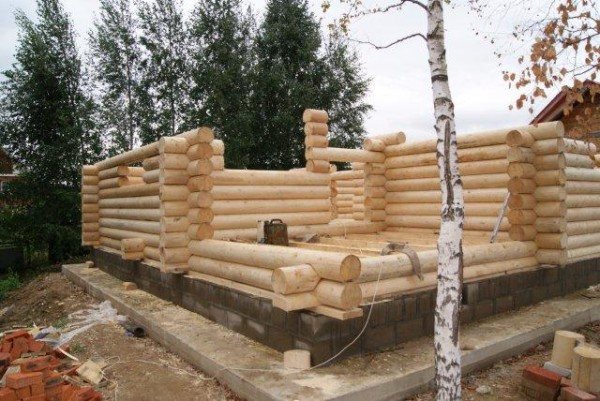
So, for example, for a strip base it is enough to use ordinary roofing felt, which should be laid on the surface of the base, preheated with bitumen.
Particular attention should be paid to how correctly the blind area is executed. Its absence can lead to the most undesirable consequences, starting with the building being skewed and ending with the complete destruction of the foundation for the bathhouse.
You need to approach the installation of the first crown with a high degree of responsibility. To do everything correctly, logs must be selected with a large diameter.
How correctly the installation is carried out is checked using a building level. The logs must be placed exactly horizontally. Upon completion of this stage of work, they are tied together and securely attached to the base.
However, not only the foundation needs insulation, but also the bathhouse itself. It is best to use polyurethane foam. It allows you to most effectively get rid of existing cracks.
Summarizing the above, it should be noted that both the choice of foundation and the depth of its laying depend on a number of factors. And although bathhouses are lightweight structures, a log bathhouse frame has a very noticeable mass. So the closest attention should be paid to the arrangement of the foundation.
Insulation of the bathhouse foundation
In order for the bathhouse to function fully, it is important to properly insulate the foundation. This is especially important for baths that are used irregularly. It is known that the heat loss of the base is up to a quarter of the heat loss of the structure as a whole.
In warm weather, a foundation without thermal insulation becomes covered with condensation, and remains damp all summer. As a result, the concrete surface becomes covered with fungus and mold. In winter, the foundation is subject to buoyant forces. In just a few years, such processes can lead to significant destruction of the support. That is why it is important to carefully insulate the foundation from the inside and outside.
Proper thermal insulation helps:
- reduce bath heating costs;
- ensure a stable temperature in the steam room;
- increase the service life of waterproofing and protect the foundation from adverse effects.
